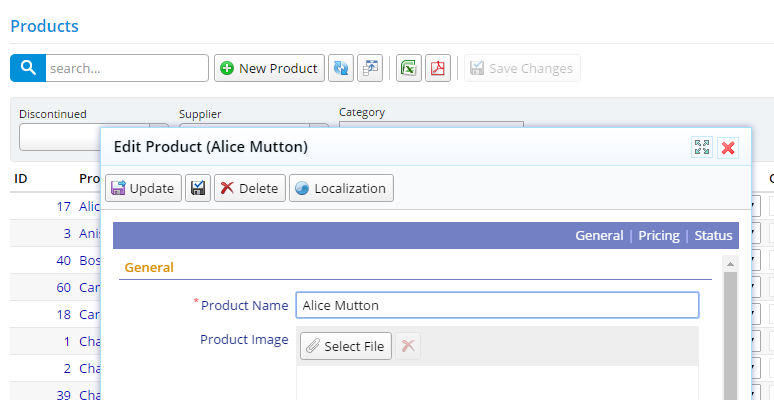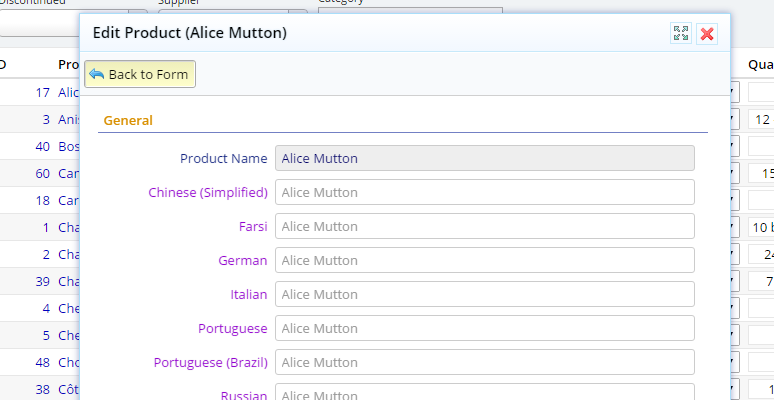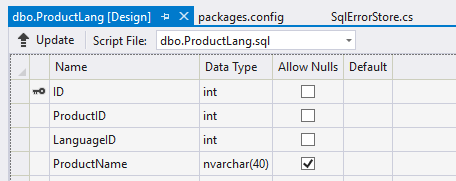How It Works in Practice
In case you didn't notice or try data localization feature in Serenity, here is how it works in Northwind Products dialog:

When you click the Localization button on toolbar, you'll get editing interface for translations:

Here we can localize Product Name in a list of languages, which is customizable.
In Product dialog, only the Product Name field is set as localizable. But, it is possible to set more than one field as localizable.
Localizations are stored in an data localization extension table. For Product table, corresponding localization table is ProductLang table which has a structure like below:

ID is the auto incrementing identity field of this localization table.
Clearly, ProductID corresponds to ProductID field in Products table, e.g. it is foreign key.
LanguageID is the language identity from our Languages table in default database. We could also use a two letter or four letter culture code instead.
ProductName is the only localizable field that is matching a field with same name in Products table. If we wanted to make another field localizable, we should first add it in this table.
Enabling Data Localization
Before talking about the simplified one, let's first see how we used to enable this feature in traditional way:
Step 1 - Create a Localization Table
First step is to create a data localization table similar to ProductLang table, with foreign key, language id, and fields that you'd like to localize.
The natural choice would be to create it using a migration, but not a necessity. You could also manually create it.
Step 2 - Generate Code for Localization Table
Using Sergen generate code for your data localization row. You'll only need to generate the Row class. You won't need any others like Repository, Endpoint, Form, Grid etc.
You'll end up with a row like this:
public sealed class ProductLangRow : Row, IIdRow, INameRow
{
public Int32? Id
{
get { return Fields.Id[this]; }
set { Fields.Id[this] = value; }
}
[DisplayName("Product Id"), Column("ProductID"), NotNull]
public Int32? ProductId
{
get { return Fields.ProductId[this]; }
set { Fields.ProductId[this] = value; }
}
[DisplayName("Language Id"), Column("LanguageID"), NotNull]
public Int32? LanguageId
{
get { return Fields.LanguageId[this]; }
set { Fields.LanguageId[this] = value; }
}
[DisplayName("Product Name"), Size(40), QuickSearch]
public String ProductName
{
get { return Fields.ProductName[this]; }
set { Fields.ProductName[this] = value; }
}
}
Step 3 - Add ILocalizationRow Interface to Data Localization Row
Serenity needs to know which field of your row is Culture ID or Language ID, so you'll need to implement ILocalizationRow interface:
public sealed class ProductLangRow : Row, IIdRow, INameRow, ILocalizationRow
{
public Field CultureIdField
{
get { return Fields.LanguageId; }
}
}
Step 4 - Add LocalizationRow Attribute to Main Row
We need to mark our main row, e.g. ProductRow, that it is a localizable row, and specify that ProductLangRow is its localization table.
Need to add LocalizationRow attribute to its definition:
[LocalizationRow(typeof(ProductLangRow))]
public sealed class ProductRow : Row, IIdRow, INameRow
{
}
Step 5 - Add a RetrieveLocalization Method to Repository
As we don't have a separate repository for ProductLang table, need a way to read list of localizations through Product service.
So we add a RetrieveLocalization method to our ProductRepository:
public class ProductRepository
{
public RetrieveLocalizationResponse<MyRow> RetrieveLocalization(
IDbConnection connection, RetrieveLocalizationRequest request)
{
return new LocalizationRowHandler<MyRow>().Retrieve(connection, request);
}
}
Luckily, LocalizationRowHandler helper class handles rest of the details for us.
Step 6 - Add a RetrieveLocalization Method to Endpoint
Adding a method to a repository doesn't mean that it is accessible as a service from client code.
So we need to reveal it from ProductEndpoint.cs:
public class ProductController : ServiceEndpoint
{
public RetrieveLocalizationResponse<MyRow> RetrieveLocalization(
IDbConnection connection, RetrieveLocalizationRequest request)
{
return new MyRepository().RetrieveLocalization(connection, request);
}
}
Step 7 - Add List of Languages to Product Dialog
To make Localization button visible, we need to add a getLanguages method to ProductDialog:
namespace Serene.Northwind {
export class ProductDialog extends Serenity.EntityDialog<ProductRow, any> {
// ..
protected getLanguages(): string[][] {
return LanguageList.getValue();
}
}
}
This will also determine which languages are available for translation in localization panel.
Build your project and you'll be able to see localization button in the dialog.
But still, after entering translations and saving the entity, you'll get a JSON deserialization error about Localizations property (if using a version < 2.8.10).
Step 8 - Modifying the Save Handler
Our save handler for ProductRow looks like this by default:
private class MySaveHandler : SaveRequestHandler<MyRow>
{
}
By default, SaveHandler works with a SaveRequest. To resolve the JSON deserialization error, and let localizations to be saved, we first need to modify MySaveHandler generic signature a bit:
private class MySaveHandler : SaveRequestHandler<MyRow,
SaveWithLocalizationRequest<MyRow>, SaveResponse>
{
}
This specifies that MySaveHandler request type is SaveWithLocalizationRequest instead of the base SaveRequest which doesn't (or didn't) include Localizations property.
Next we need to handle the save using some help from LocalizationRowHandler by overriding AfterSave method:
private class MySaveHandler : SaveRequestHandler<MyRow,
SaveWithLocalizationRequest<MyRow>, SaveResponse>
{
protected override void AfterSave()
{
base.AfterSave();
if (Request.Localizations != null)
foreach (var pair in Request.Localizations)
{
pair.Value.ProductID = Row.ProductID.Value;
new LocalizationRowHandler<MyRow>().Update<Entities.ProductLangRow>(
this.UnitOfWork, pair.Value, Convert.ToInt32(pair.Key));
}
}
}
After the main entity (Product) is saved, this will make sure that Localizations are also saved into ProductLang table.
Step 9 - Modifying Create and Update Repository Methods
As our save handler's request type is changed, need to modify signatures of Create and Update methods accordingly:
public SaveResponse Create(IUnitOfWork uow, SaveWithLocalizationRequest<MyRow> request)
{
return new MySaveHandler().Process(uow, request, SaveRequestType.Create);
}
public SaveResponse Update(IUnitOfWork uow, SaveWithLocalizationRequest<MyRow> request)
{
return new MySaveHandler().Process(uow, request, SaveRequestType.Update);
}
We changed SaveRequest to SaveWithLocalizationRequest in these methods.
Step 10 - Modifying Create and Update Endpoint Methods
As these methods are serviced from our Endpoint.cs, need to do similar modification in that file too:
public class ProductController : ServiceEndpoint
{
[HttpPost, AuthorizeCreate(typeof(MyRow))]
public SaveResponse Create(IUnitOfWork uow, SaveWithLocalizationRequest<MyRow> request)
{
return new MyRepository().Create(uow, request);
}
[HttpPost, AuthorizeUpdate(typeof(MyRow))]
public SaveResponse Update(IUnitOfWork uow, SaveWithLocalizationRequest<MyRow> request)
{
return new MyRepository().Update(uow, request);
}
//...
}
Step 11 - Take a Deep Breath
If you were able to follow steps so far, without making some mistakes along the way, your data localization should be working properly.
Even if it's a matter of copy paste, and we made use of some helpers like LocalizationRowHandler, it is still too much.
More manual steps means more mistakes, and even if you are lucky, you'll end up with more code to maintain.
I probably don't need to repeat that i prefer declarative code where possible or where i could design it. I was thinking for some time about how to simplify this and make it declarative, so here is what i came up with...
Simplified Declarative Way Using a Service Behavior
Starting with 2.8.10 we have a LocalizationBehavior that activates automatically for all rows that has a LocalizationRow attribute.
That means everything after Step 4 becomes unnecessary.
If you did any of the changes in those steps, you can just delete/revert them.
It will still work if you leave them as is, but you'll be double saving localizations in worst case.
If you have an existing application, you'll need to do a little change in ScriptInitialization.cs:
Serenity.EntityDialog.defaultLanguageList = LanguageList.getValue;
Add this line at the bottom of others. This will remove the need for getLanguages in Dialog.ts files, e.g. Step 7.